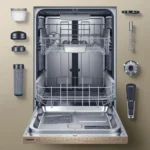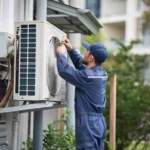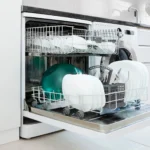Electrolux washers are known for their durability, reliability, and innovative features, making them a popular choice for homeowners worldwide. However, like any appliance, they can occasionally experience issues. When that happens, it’s essential to understand how to troubleshoot and repair your Electrolux washer to ensure it continues to perform at its best. In this comprehensive guide, we will cover common Electrolux washer issues, provide troubleshooting tips, and discuss when it might be time to call in a professional for washer repair services.
Our Appliance Repair Services:
Microwave Repair Service in Southern CaliforniaWasher Repair Service in Southern California
Freezer Repair Service in Southern California
Dishwasher Repair Service in Southern California
Refrigerator Repair Service in Southern California
Common Electrolux Washer Problems
Before diving into troubleshooting and repair, it’s essential to identify the most common problems that Electrolux washing machines may experience. Here are some of the most frequent issues with Electrolux washers:
- Washer Not Draining Properly
If your Electrolux washer isn’t draining water, it could be due to a clogged drain hose, a faulty pump, or issues with the water inlet valve.
- Washer Not Spinning
A washer that isn’t spinning could indicate a problem with the motor, lid switch, or the Washer’s belt. In some cases, an overloaded washer or unbalanced load may also prevent spinning.
- Washer Leaks Water
Damaged door seals, a clogged drain pump filter, or a cracked hose often cause water leakage in Electrolux washers. It’s crucial to inspect these components to prevent further damage.
- Washer Won’t Start
If your Electrolux washer isn’t starting, check for issues with the power supply, door latch, or faulty control board. In some cases, a blown fuse or electrical failure may be the culprit.
- Excessive Washer Vibration
Excessive shaking during operation may occur due to an uneven load, damaged suspension springs, or worn shock absorbers. To resolve this, ensure that the laundry load is balanced or replace any defective components if necessary.
- Issues with Washer Filling Water
When the Washer fails to fill, it might be due to a blocked or malfunctioning water inlet valve, a bent water hose, or an issue with the pressure switch. Inspect and fix these areas to restore proper functionality.
- Washer Stops Mid-Cycle
A washer that stops mid-cycle might have a damaged door latch, faulty timer, or issues with the motor.
- Unusual Noises
Strange noises during the wash cycle could be caused by loose or broken parts inside the Washer, such as a worn-out agitator or malfunctioning motor.
Troubleshooting Electrolux Washer Issues
- Washer Not Draining Properly
Possible Causes:
- A blocked drain hose or filter
- Malfunctioning drain pump
- Problems with the water inlet valve
Steps to Resolve:
- Inspect for Blockages: Examine the drain hose for any obstructions or bends. Check the drain pump filter for accumulated debris or lint, and clean these areas thoroughly to allow water to flow freely.
- Evaluate the Drain Pump: If the pump fails to function, it may be damaged and require replacement to ensure the Washer drains correctly. Listen for any unusual sounds when the washer attempts to drain, which could indicate pump failure.
- Water Inlet Valve Inspection: If the water inlet valve is malfunctioning, water may not flow freely into the Washer, which can lead to drainage issues.
- Washer Not Spinning
Possible Causes:
- Faulty lid switch
- A broken belt or drive motor
- Overloaded Washer
How to Fix:
- Check the Lid Switch: If the Washer’s lid switch is faulty, the machine may not spin.
- Examine the Belt and Motor: If the belt is worn out or the motor is malfunctioning, it may need to be replaced. A damaged drive motor or a snapped belt might hinder the Washer’s ability to spin.
- Prevent Overloading: Make sure to load the Washer within its capacity limits to avoid unnecessary strain on its components. Overloading can cause the Washer to become unbalanced, preventing it from spinning.
- Washer Leaking Water
Possible Causes:
- Damaged door seal
- Cracked drain hose
- Clogged pump filter
How to Fix:
- Inspect the Door Seal: Check the door seal for tears, cracks, or mold buildup. If damaged, the seal should be replaced.
- Check the Drain Hose: Inspect the drain hose for leaks or cracks. Replace any damaged hoses to prevent further water leakage.
- Clean the Pump Filter: A clogged pump filter can cause water to leak. Clean the filter to restore proper water flow.
- Washer Won’t Start
Possible Causes:
- Power supply issues
- Problems with the door latch or control module
- Circuit breaker interruptions
Steps to Address the Issue:
- Ensure Power Connectivity: Confirm that the Washer is properly plugged in and the outlet is functional. Test the outlet using another device to verify its power supply.
- Check the Door Lock: A damaged or misaligned door latch may prevent the Washer from starting. Inspect for any loose or broken components, and replace the latch if needed.
- Inspect the Control Module: A faulty control board can halt the Washer’s operation. Look for visible damage or wear and replace the board if it’s no longer operational.
- Washer Vibrating Excessively
Possible Causes:
- Unbalanced load
- Worn suspension springs or shock absorbers
How to Fix:
- Even Out the Load: Verify that the Washer is loaded within its capacity and that the items inside are evenly distributed. An unbalanced load can lead to significant vibrations during operation.
- Check Suspension Components: Worn or damaged suspension springs or shock absorbers can cause instability. Inspect these parts, and if they show signs of wear, replace them to stabilize the Washer during cycles. These parts are critical to minimizing vibrations and keeping the Washer stable.
- Washer Not Filled with Water
Possible Causes:
- Faulty water inlet valve
- Kinked hose
- Pressure switch issues
How to Fix:
- Inspect the Water Inlet Valve: A faulty water inlet valve can block water from entering the Washer. Check for clogs or damage, and replace the valve if it’s not functioning properly.
- Look for Blockages in the Hose: Make sure the water supply hose is free from kinks or obstructions, as these can disrupt the water flow into the machine.
- Evaluate the Pressure Switch: The pressure switch regulates the Washer’s water levels. If it’s defective, the Washer might not fill. Test the switch for proper functionality and replace it if necessary.
- Washer Stops Mid-Cycle
Possible Causes:
- Faulty door latch or timer
- Motor issues
- Control board malfunction
How to Fix:
- Test the Door Latch: If the door latch is not engaging properly, the Washer may stop mid-cycle.
- Examine the Timer and Control Board: A malfunctioning timer or control board may cause the Washer to stop unexpectedly.
- Unusual Noises During Washing
Possible Causes:
- Loose or broken parts inside the Washer
- Worn-out agitator
- Malfunctioning motor
How to Fix:
- Inspect for Loose Parts: Check inside the Washer for any loose components or debris that could be causing noise. Tighten or remove any loose parts.
- Examine the Agitator: A malfunctioning agitator can produce grinding or thumping noises.
When to Call a Professional for Electrolux Washer Repair
While many common Electrolux washer issues can be fixed with a little troubleshooting and some basic tools, some problems may require the expertise of a professional repair technician. Here are some situations where it’s best to call in a pro:
- Persistent Issues: If you’ve tried troubleshooting the issue and it persists, it may be time to call a professional for a more thorough diagnosis. A qualified technician can often identify hidden problems that you may have missed.
- Electrical or Control Board Problems: Issues with electrical components or the control board can be complicated to fix and may require a technician’s expertise. These components can be expensive to repair and require expertise, so they should only be handled by trained professionals.
- Protect Your Warranty: If your Electrolux washer is still under warranty, reach out to an authorized service center for repairs. Attempting repairs through unauthorized technicians may invalidate the warranty, so it’s advisable to use approved service providers to safeguard your coverage.
- Lack of Time or Expertise: If you’re unsure about how to fix your Washer or don’t have the time to dedicate to a repair, a professional technician can help. They can quickly diagnose the issue and perform the repair to get your Washer back in action without the hassle.
How to Prevent Electrolux Washer Problems
Preventative maintenance can go a long way in ensuring the longevity of your Electrolux washer. Here are a few tips to keep your Washer in top condition:
- Clean the Washer Regularly: Clean the drum, filter, and detergent dispensers regularly to prevent clogs and buildup. Mold, mildew, and detergent residue can accumulate over time, causing odors and affecting washer performance.
- Choose the Appropriate Detergent: Ensure you’re using the right detergent formulated for your washer type to maintain optimal performance. High-efficiency (HE) washers, like most Electrolux models, require HE detergent to prevent excessive sudsing and buildup.
- Balance Loads Properly: Always balance your loads in the Washer to prevent strain on the motor and suspension system. This reduces the chances of excessive vibrations and damage to components.
- Check Hoses and Seals: Periodically examine the hoses and door seals for signs of wear. Replace any damaged parts immediately to prevent water leakage.
- Don’t Overload the Washer: Overloading the Washer can put excess strain on the motor and suspension system. Always adhere to the manufacturer’s load capacity recommendations to ensure longevity and optimal performance.
By implementing these troubleshooting tips and maintenance practices, you can help keep your Electrolux washer functioning efficiently for years to come. Whether you’re
tackling minor issues on your own or relying on professional repair services, keeping your Washer well-maintained will help avoid costly repairs and ensure smooth operation.

Eric
Eric is the founder and lead repair expert at Appliance Repair Southern California. With 17+ years of experience, he has built a reputation for providing fast, reliable, and high-quality repair services across Southern California. His expertise covers a wide range of appliances, including refrigerators, ovens, dishwashers, and washing machines. Eric is committed to exceptional customer service and ensuring every repair is done right the first time. Under his leadership, Appliance Repair Southern California continues to be a trusted name in the industry.







